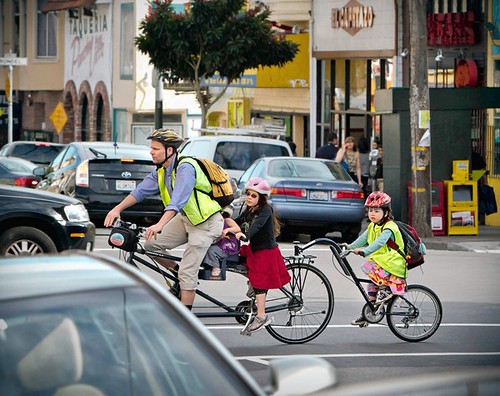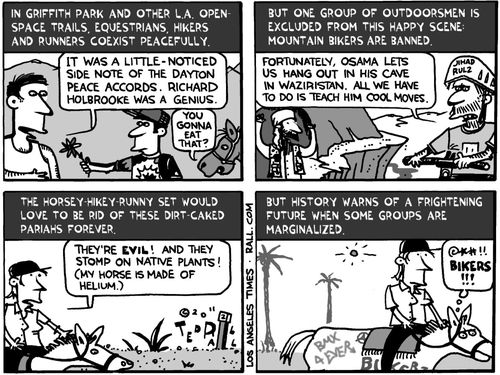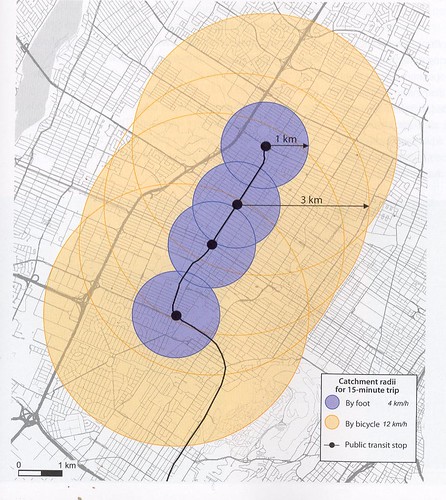Bicycling roundup
Bicycling in New York is not more dangerous for women than men, but women may be less inclined to engage in something that is perceived to be risky, experts said; high-profile bicycle fatalities, like the death on Saturday of Marilyn Dershowitz, a retired special referee in State Supreme Court in Manhattan and the sister-in-law of the lawyer Alan M. Dershowitz, add to the perception.
City officials and local bike advocacy groups say they have focused more on making cycling safer for all New Yorkers, not just women. One group, Transportation Alternatives, offers a women’s bicycle repair class, and it has also attracted more women to events for both men and women like group rides and its bike ambassador program, which pairs up cyclists, said Caroline Sampanaro, the group’s director of bicycle advocacy. The city’s transportation commissioner, Janette Sadik-Khan, stressed its programs — like adding 250 miles of bicycle lanes over the past four years — help all cyclists.
A comparison of the Department of Motor Vehicles (DMV) manuals between Oregon and Virginia yields very different attitudes towards bicycling education. The Oregon manual mentions the word bicycle 54 times versus the paltry 14 times counted in the Virginia DMV manual.
Recently, Michael Gilbert, founder of bicycling education non-profit Ride Richmond, sent a letter off to Robert D. Holcomb, asking the Commissioner to update the DMV manual. The letter was signed by local and state bicycling saftey advocates.
I mentioned something similar as an issue in Maryland, in a supplement (not published) to the Western Baltimore County Pedestrian and Bicycle Access Plan. The Maryland manual does mention bicycling, maybe not as much as Oregon either, but I suggested that people be regularly retested on pedestrian and bicycle related issues, as a kind of refresher and reminder of the rules of the road.
7. We know about "bikelash" in DC and elsewhere, including New York City. While DC appears to be dialing back on cycletracks, including on what could be the most important set of cycletracks that the city could create on L and M Streets NW, Christopher alerts us to the opening of a new cycletrack in Queens, linking the Queensborough Bridge and Manhattan, as reported by Streetsblog, "The Queens Plaza Protected Bike Path Is Open for Business."
As the film shows, it's BEAUTIFUL and shows how a city focused on quality of life can be uplifting.
Queens Plaza Protected Cycletrack is Open For Business from Streetfilms on Vimeo.
8. There has been lots of coverage of Chicago's new transportation director, Gabe Klein, who wasn't retained as transpo director in DC, and his focus on bike infrastructure development and promotion. Biking promotion was a priority of Mayor Daley too, so it's good to see that this commitment is not only being maintained but expanded under Mayor Emanuel. See "New head of Chicago transportation wants more biking" from the Chicago Journal blog.
Not unrelatedly, Ottawa, Ontario just added a cycletrack, see "Bike lanes earn rave reviews on first morning commute" from the Ottawa Citizen and already citizens want more connections, not unlike the point I made in this entry last week, "Thinking a lot bigger for DC's bikeways (cycletracks)."
9. While I feel like most articles published in newspapers seem to be whiny anti-bike screeds, it's not the case for the Los Angeles Times. Check out "Los Angeles needs an attitude adjustment regarding bicyclists."
10. The LA Times also two nice travel articles about biking, in San Francisco, "San Francisco's Valencia Street on bicycle: The Valencia Street bike corridor is a hip, mostly flat route in the Mission District. Here are some restaurants and other stops to explore along the way" and in other places, in "A healthy dose of American history: A writer explores historic landmarks in Boston, Philadelphia and New York by foot, bike and kayak" and by running, "Jog your way around New York." I gather the Travel section that week focused on active vacations.
A family makes its way along the Valencia Street bike corridor in San Francisco. (Chris Hardy / July 10, 2011)
11. Hikers and horseback riders vs. bikers cartoon by Ted Rall from the LA Times.
12. Not really about biking, but how about urine management plans for the Olympic National Park in Washington State. See "Keep distance, don’t urinate: Olympic National Park revises plan in wake of goat-goring death" from the Peninsula Daily News. My understanding of the wide ranging nature of parks planning continues to expand.
Labels: bicycling, transportation planning, urban design/placemaking




1 Comments:
Thanks for the great giveaway.
Post a Comment
<< Home